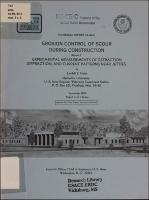Please use this identifier to cite or link to this item:
https://hdl.handle.net/11681/13636Full metadata record
| DC Field | Value | Language |
|---|---|---|
| dc.contributor.author | Hales, Lyndell Z. | - |
| dc.date.accessioned | 2016-08-18T19:14:57Z | - |
| dc.date.available | 2016-08-18T19:14:57Z | - |
| dc.date.issued | 1980-09 | - |
| dc.identifier.uri | http://hdl.handle.net/11681/13636 | - |
| dc.description | Technical Report | - |
| dc.description | Abstract: Effective, comprehensive, and low cost procedures do not exist for eliminating scour during construction in the nearshore environment. Determination of potential alternative procedures is seriously hampered by the inability to predict the extent of potential scour. The objectives of this research program are to develop techniques to minimize and control scour during nearshore construction and to predict the probable magnitude of scour that may result as a function of currents and wave climate. One phase of the research effort is the development of numerical techniques (incorporating both refraction and diffraction effects near the structure) for computing wave-induced velocities and tidal currents in the vicinity of structures and applying these results to determine sediment transport of the bottom material at the particular site. The purpose of this study was to obtain detailed and precise experimental data regarding wave-height variations and currents (patterns and magnitudes) downwave from a shore-connected breakwater or jetty under the simultaneous effects of refraction and diffraction. This information provides insight into the phenomenon of combined wave refraction and diffraction and can be used to verify numerical models that simulate this phenomenon. The experimental investigation was conducted in a wave basin that was molded in cement mortar and consisted of an area 50 ft x 60 ft with a water depth of 1 ft in the open-ocean region. A vertical, impermeable breakwater (shore-connected) extending perpendicularly from the shoreline was installed on a beach slope of 1V on 20H. In the neighborhood of the breakwater, currents existed that affected the wave heights. The magnitude of these wave-induced return currents is a function of incident wave characteristics. The effect of varying the incident wave height on the wave-height amplification factor, H/Hₒ, was investigated and it was determined that the greatest variation in H/Hₒ occurred in the deep shadow zone near the breakwater and shore region where the currents are the strongest. This nonlinear effect diminishes rapidly away from the structure, and at a distance of 5 ft (model dimensions) downwave appears to be relatively insignificant except for the extreme shadow region at acute angles of incidence. The establishment of a counterclockwise circulation cell approximately 4 ft wide adjacent to the downwave side of the breakwater results in a seaward flowing current all along the breakwater. The bottom current is especially intense approximately 40 percent of the breakwater length from the shoreline and decreases seaward along the structure. The physical model sidewall boundary was responsible for a clockwise circulation cell which developed as a result of mass transport downcoast by the nearshore current. Based on these experiments, any numerical techniques for describing scour and erosion near structures should account for wave-induced currents and circulation cells near the structure as well as tidal or other currents that may exist in the near region. | - |
| dc.publisher | Hydraulics Laboratory (U.S.) | - |
| dc.publisher | Engineer Research and Development Center (U.S.) | - |
| dc.relation | http://acwc.sdp.sirsi.net/client/en_US/search/asset/1033560 | - |
| dc.relation.ispartofseries | Technical report (U.S. Army Engineer Waterways Experiment Station) ; HL-80-3 rept.3. | - |
| dc.rights | Approved for public release; distribution is unlimited. | - |
| dc.source | This Digital Resource was created from scans of the Print Resource | - |
| dc.subject | Construction practices | - |
| dc.subject | Erosion control | - |
| dc.subject | Harbor structures | - |
| dc.subject | Scour | - |
| dc.subject | Construction projects | - |
| dc.subject | Water waves | - |
| dc.subject | Jetties | - |
| dc.subject | Jetty | - |
| dc.subject | Sediment transport | - |
| dc.subject | Sedimentation | - |
| dc.subject | Deposition | - |
| dc.subject | Coastal structures | - |
| dc.subject | Hydraulic structures | - |
| dc.title | Erosion control of scour during construction. Report 3, Experimental measurements of refraction, diffraction, and current patterns near jetties | - |
| dc.type | Report | en_US |
| Appears in Collections: | Technical Report | |
Files in This Item:
| File | Description | Size | Format | |
|---|---|---|---|---|
| TR-HL-80-3-Report.pdf | 12.72 MB | Adobe PDF |  View/Open |